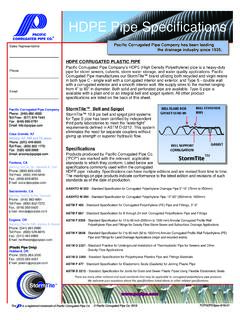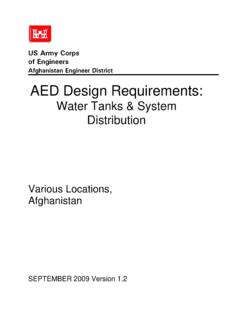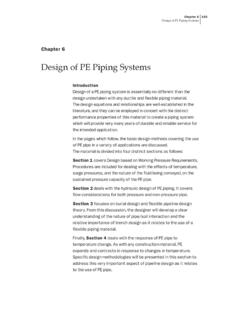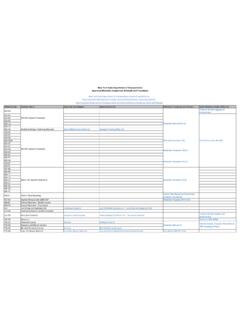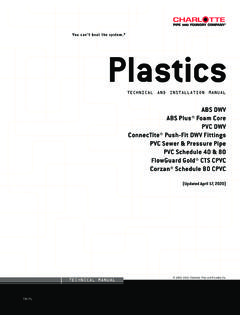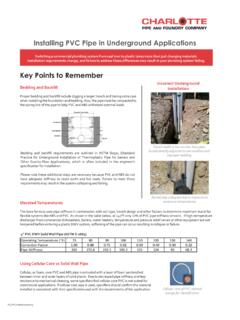Transcription of Pipe Construction - US EPA
1 United StatesEnvironmental ProtectionAgencyOffice of WaterWashington, 832-F-00-068 September 2000 WastewaterTechnology Fact SheetPipe Construction and MaterialsDESCRIPTIONT here are several different pipe materials availablefor wastewater collection systems, each with aunique characteristic used in different four different pipe materials described in thisfact sheet are ductile iron, concrete, plastic, andvitrified material selection considerations includetrench conditions (geologic conditions), corrosion,temperature, safety requirements, and cost. Keypipe characteristics are corrosion resistance (interiorand exterior), the scouring factor, leak tightness,and the hydraulic manufacturers follow requirements set by theAmerican Society of Testing Materials (ASTM) orAmerican Water Works Association (AWWA) forspecific pipe materials.
2 Specification standardscover the manufacture of pipes and specifyparameters such as internal diameter, loadings(classes), and wall thickness (schedule). Themethods of pipe Construction vary greatly with thepipe materials. Some new pipe materials and Construction methodsuse the basic materials of concrete pipes withmodifications ( , coatings). Other pipemanufacturing methods use newly developed resinswhich offer improvements in strength, flexibility,and resistance to certain chemicals. Constructionmethods may also allow for field modifications toadapt to unique conditions ( , river crossings,rocky trenches, etc.)
3 Or may allow for special,custom ordered diameters and Iron PipeDuctile iron pipe (DIP) is an outgrowth of the castiron pipe industry. Improvements in the metallurgyof cast iron in the 1940's increased the strength ofcast iron pipe and added ductility, an ability toslightly deform without cracking. This was a majoradvantage and ductile iron pipe quickly became thestandard pipe material for high pressure service forvarious uses (water, gas, etc.).Concrete PipeTwo types of concrete pipe commonly used todayare prestressed concrete cylinder pipe (PCCP) andreinforced concrete pipe (RCP). PCCP is used forforce mains, while RCP is used primarily forgravity lines.
4 PCCP may be of either embedded-cylinder (EC) or lined-cylinder Construction (LC).The Construction process for both the LC and ECbegins by casting a concrete core in a steel single process produces the LC pipe . Once thecylinder cures, it is wrapped with a prestressed steelwire and coated with a cement slurry and a densemortar or concrete coating to produce the EC manufacturing process for reinforced concretecylinder pipe (RCCP) is similar to embedded-cylinder, however, a reinforcing cage and the steelcylinder are positioned within a reusable verticalform and the concrete is cast instead of using theprestressed wire.
5 RCCP can be cured by usingeither water or PipePlastic pipe is made from either thermoplastic orthermoset plastics. Characteristics and constructionvary, but new materials offer high strength andgood rigidity. Fluorocarbon plastics are the mostresistant to attack from acids, alkalies, and organiccompounds, but other plastics also have highchemical resistance. Plastic pipe design mustinclude stiffness, loading , and hydrostatic designstress requirements for pressure piping. Thermoplastics are plastic materials which changeshape when they are heated. Common plastics usedin pipe manufacturing include Polyvinyl Chloride(PVC), Polyethylene (PE or HDPE for High-Density PE), Acrylonitrile-butadiene-styrene(ABS), and Polybutylene (PB).
6 HDPE iscommonly used with pipe bursting. PVC is strong,lightweight, and somewhat flexible. PVC pipe isthe most widely used plastic pipe material. Otherplastic pipes or composites with plastics and othermaterials may be more plastics are rigid after they have beenmanufactured and are not able to be plastic pipes are composed of epoxy,polyester, and phenolic resins, and are usuallyreinforced with fiberglass. Resins may containfillers to extend the resin and to provide specificcharacteristics to the final material. The glass fibersmay be wound around the pipes spirally, in wovenconfigurations, or they may be incorporated into theresin material as short strands.
7 The pipes may becentrifugally cast. Stiffness may also be added inconstruction as external ribs or Plastic Mortar (RPM) and ReinforcedThermosetting Resin (RTR) (or FiberglassReinforced Plastic pipe (FRP)) are the two basicclasses of these pipes. Another name is FiberglassReinforced Polymer Mortar (FRPM). Thermosetpipes are often manufactured according to thespecific buyer requirements and may include linersof different composition for specific chemical plastic pipes, resins composed of polymerizedmolecules are mixed with lubricants, stabilizers,fillers, and pigments, to produce mixtures withdifferent characteristics.
8 Plastic pipes are generallyproduced by extrusion. Plastic pipe may be usedfor sliplining or for rehabilitating existing pipes byinserting or pulling them through a smaller diameterpipe. HDPE pipes may also be used for burstingand upgrading. The smaller diameter pipe may beanchored into place with mortar or Clay PipeVitrified clay pipes are composed of crushed andblended clay that are formed into pipes, then driedand fired in a succession of temperatures. The finalfiring gives the pipes a glassy finish. Vitrified claypipes have been used for hundreds of years and arestrong, resistant to chemical corrosion, internalabrasion, and external chemical attack.
9 They arealso heat resistant. These pipes have an increasedrisk of failure when mortar is used in joints becausemortar is more susceptible to chemical attack thanthe clay. Other types of joints are more chemicallystable. It has been shown that the thermalexpansion of vitrified clay pipes less than manyother types (such as DIP and PVC).APPLICABILITYThe applicability of different pipe materials varieswith each site and the system requirements. Thepipe material must be compatible with the soil andgroundwater chemistry. The pipe material alsomust be compatible with the soil structure andtopography of the site, which affects the pipelocation and depth, the supports necessary for thepipe fill material, and the required strength of thepipe material.
10 The following list shows backgroundinformation to be used in determining what type ofpipe best fits a particular situation: Maximum pressure conditions (forcemains). Overburden, dynamic, and static loading. Lengths of pipe available. Soil conditions, soil chemistry, water table,stability. Joining materials required. Installation equipment required. Chemical and physical properties of thewastewater. Joint tightness/thrust control. Size range requirements. Field and shop fabrication considerations. Compatibility with existing systems. Manholes, pits, sumps, and other requiredstructures to be included.










